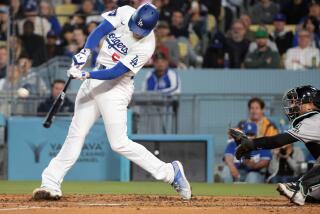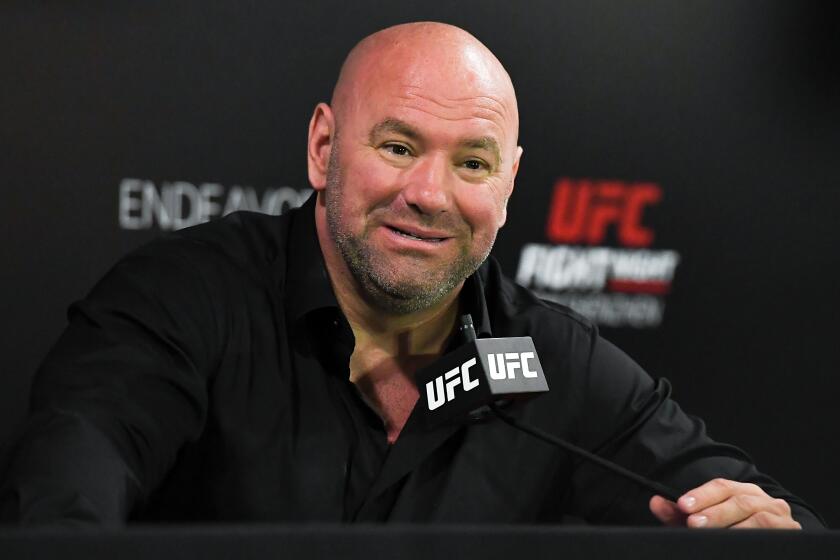Shelters Needed--for Taxes : Boxing: Holyfield-Foreman fight is said to be richest ever, but neither man is a stranger to poverty. Champion is a heavy favorite tonight.
ATLANTIC CITY, N.J. — The incongruity of it all--the notion that two athletes could come to this setting tonight and divvy up $30 million for a fistfight--is almost as stunning as this improbable boxing promotion.
A few blocks up Atlantic City’s famed Boardwalk, past block after block of some of America’s flashiest hotels, are block after block of some of America’s worst ghettos.
There are burned-out and boarded-up houses. Burned-out cars. Razed lots, strewn with garbage. Skinny, stray dogs. Discarded mattresses. Just off the Boardwalk, a child walks carefully through the broken glass in an empty lot, seeking aluminum cans.
And under the Boardwalk, a life-and-death search for warmth is in progress. On a cold, windy morning, two vagrant men huddle under an old yellow tarpaulin, seeking shelter from the cold that blows off the Atlantic Ocean.
Overhead, on the Boardwalk, trim joggers and cyclists fly by, and few see the men below.
On Pacific Avenue, a block off the Boardwalk, it’s a nighttime parade of hookers, pimps, panhandlers, con artists and derelicts. It isn’t uncommon to see drug deals going down on street corners.
But a 15-minute walk south on the Boardwalk takes you to the hotel district and the 62-year-old Atlantic City Convention Hall. There, before 19,000 spectators and a worldwide pay-per-view television audience tonight, two products of Atlanta and Houston ghettos will fight for the world heavyweight championship.
It is being pegged as the richest fight in history, one that could gross, according to its promoters, $100 million. The champion, Evander Holyfield of Atlanta, is in for a guaranteed $20 million. The challenger, George Foreman of Marshall, Tex., gets a minimum $12.5 million.
Last Oct. 25, when Holyfield (25-0) won the championship by knocking out Buster Douglas in Las Vegas, home pay-per-view sales were by far the highest ever for a boxing match, $38.6 million. This week, co-promoter Dan Duva said Holyfield-Foreman pay-per-view sales had surpassed Holyfield-Douglas by the close of business Monday. Normally, about half of pay-per-view sales occur in the last 48 hours before a fight.
Most boxing people don’t give Foreman (69-2 overall, 24-0 since 1987) much of a chance tonight, for several reasons:
--He is 42, weighs 257 pounds, is ponderously slow and has fought 24 weak opponents in a comeback that began 49 months ago in Sacramento. Further, Foreman rejected numerous comeback opponents--Anders Eklund, Reynaldo Snipes, Michael Dokes, etc.--along the way, leading one to wonder: If he feared those guys, how confident can he be against Holyfield, a vastly superior opponent to those he rejected?
--Even when Foreman was 22 and a rock-hard 220 pounds, he didn’t have much staying power. In 1974, Muhammad Ali exposed him as a three-round fighter when he let Foreman punch himself out, then knocked him out.
--Foreman’s opponent is 28, in magnificent shape, a proven knockout puncher who has shown he can fight hard for 12 rounds.
--Foreman’s vaunted power may not be as potent as advertised. The promoters--Dan Duva and Bob Arum--have made much of the fact Foreman has knocked out 23 of 24 on his comeback. The fact is, most of those opponents were on their feet when the fights ended.
Brazilian Adilson Rodrigues, the only common opponent, had climbed to his feet--although in no condition to continue--when Foreman took him out with a left hook. Holyfield knocked Rodrigues out for five minutes.
So, the obvious question before what seems to be a mismatch is this: Why has America bought this fight big time?
The obvious answer: George Foreman.
Evander Holyfield is a pleasant, polite fellow who has had virtually nothing to say. And really, if you’re the promoter, with Foreman doing a sensational job of selling this match, you don’t want Holyfield to say anything.
Foreman has undergone one of the most remarkable transformations of any prominent athlete in American history.
When he was the heavyweight champion in the early 1970s, even his cornermen were afraid of him. So were sportswriters. He snarled at everyone. As a teen-ager, in his pre-boxing life, he said he enjoyed it when other people would cross the street rather than come face to face with him.
One of the goals in his Houston hoodlum days was, he said, to have a knife scar running down the length of his face.
“Even Doberman pinschers were afraid of me when they saw me coming,” he recalled recently.
In his early boxing years, he played the role of the thug. But inside, he says now, he harbored the fears of any man.
“I was scared to death the night (in 1973) I fought Joe Frazier, but I didn’t show it,” he said the other day. “My first few years in boxing, I kept hoping Frazier would have some kind of accident and have to get out of boxing.”
No fear tonight, he said.
“Joe Frazier would make anybody’s knees shake,” he said. “Holyfield is not the kind of fighter that makes your knees shake. Frazier could spill you all over the canvas with one punch. Holyfield is the kind of guy who, if he doesn’t knock you down, says to himself: ‘OK, I’ll beat him on points.’ ”
The stakes for Foreman’s return to championship boxing after a 16 1/2-year absence have climbed dramatically in four years. Early in his comeback, Arum signed him to a contract that would have earned him $3 million for a title fight with Mike Tyson and, if he won, $7 million for a first defense.
Four years later, the boom in pay-per-view has raised the ante to $12.5 million. Should Foreman win, a first defense would get him $20 million-plus.
In 1984, Foreman was in Los Angeles to accept an award for his work with troubled boys in Houston. He looked as if he weighed more than 300 pounds, and a reporter asked him what his weight was.
“None of your business,” he snapped, glaring.
But somewhere in 1987 or ‘88, Foreman discovered that when he told a joke about overindulging in cheeseburgers, or about his waistline, or about his age, people responded. They saw in him their own guilts and frailties. And they laughed with him.
Further, Foreman observed, people liked him when they laughed with him. And so they bought George Foreman. And they will pay the $39.95 to watch the gun lap of his long comeback. Gradually, Foreman found he enjoyed talking about himself, his waistline, his cheeseburger addiction, his age and his dreams.
George Foreman, as he became a cupcake instead of Dracula and ascended to the No. 1 spot on boxing’s all-interview team--dropping welterweight Marlon Starling into second place--became a road show. The public’s love affair with the new George began to snowball.
Arum marvels at Foreman’s sense for promotion. At a Los Angeles Holyfield-Foreman news conference a couple of months ago, after Foreman had held several dozen media members spellbound for more than an hour, Arum was in disbelief.
“We haven’t had a guy like this since Ali,” he said. “He’s absolutely sensational, a promoter’s dream.”
Foreman has become such a media darling, one printed report has it he may be asked one day to run for governor of Texas.
“How about President?” Arum said.
The promoter’s dream did something Wednesday unheard of in modern boxing. Unannounced, he walked into the working press room and sat down. Jaws dropped. Days before a major fight, boxers traditionally hole up in their $1,000-a-day suites, emerging only to train or for early morning roadwork. They are seen only at workouts (if they choose to let the media in), the obligatory prefight news conference and the weigh-in.
But Wednesday, Foreman spoke about 100 reporters for nearly two hours. Whispered one reporter to another: “Can you imagine Tyson doing this?”
Those who like Foreman’s prospects tonight most often point out that Holyfield is relatively easy to hit, that he won’t stand up long to Foreman if the challenger finds the range. And Foreman agrees.
Foreman: “Even a guy who takes a good shot, when you hit him with a real shot once, twice, three times, four times . . . eventually, a little light goes on in his head and it says to him: ‘OK, I can only take so many of those . . . ‘ And soon after that, the fight’s over.
“See, Holyfield’s whole training focus is strength and endurance. But no one can teach you how to take shots. He’s a product of his corner. I am a corner.”
In a sense, Foreman has already won. In 1987, when he began his comeback in quest of a title fight against Tyson, no one gave him a chance. So, Foreman sold America on this match. George made the Big Show.
TALE OF THE TAPE The tale of the tape for tonight’s heavyweight title fight between Evander Holyfield and George Foreman at Atlantic City, N.J.:
Holyfield Foreman 28 Age 42 208 Wieght 257 6-2 1/2 Height 6-4 77 1/2 Reach 79 43 Chest (normal) 48 45 Chest (expanded) 50 16 Biceps 17 12 1/2 Forearm 14 1/2 32 Waist 38 1/2 22 Thigh 28 1/2 13 Calf 20 19 1/2 Neck 18 7 1/2 Wrist 12 12 1/2 Fist 13 1/2 10 Ankle 13
Source: Associated Press
* MIKE DOWNEY: The heavyweight title could take a pounding if George Foreman dethrones Evander Holyfield. C8
More to Read
Go beyond the scoreboard
Get the latest on L.A.'s teams in the daily Sports Report newsletter.
You may occasionally receive promotional content from the Los Angeles Times.










